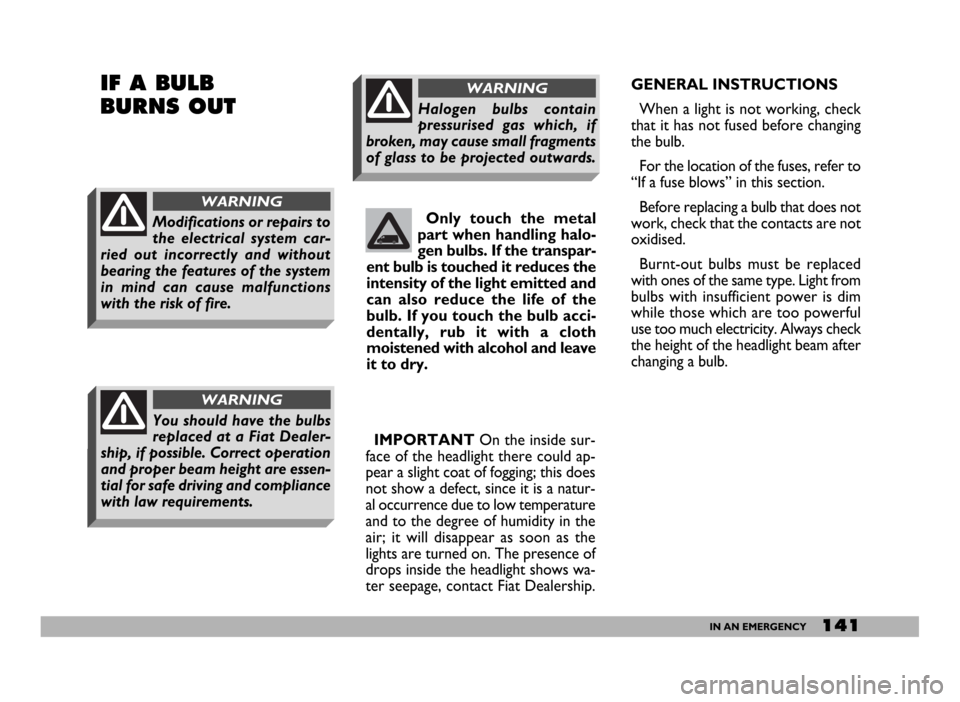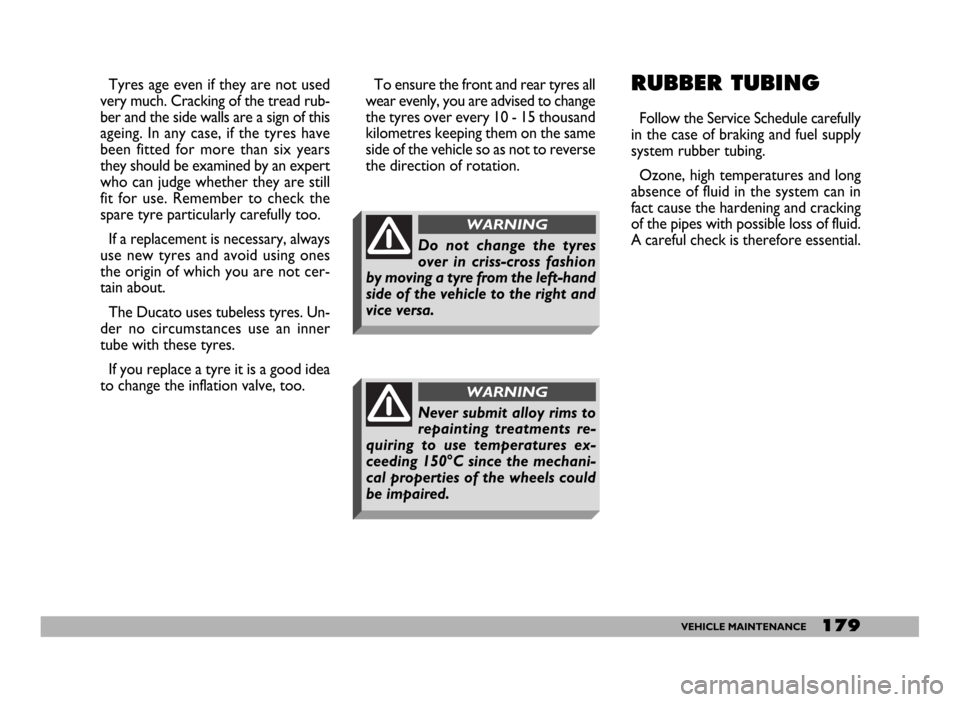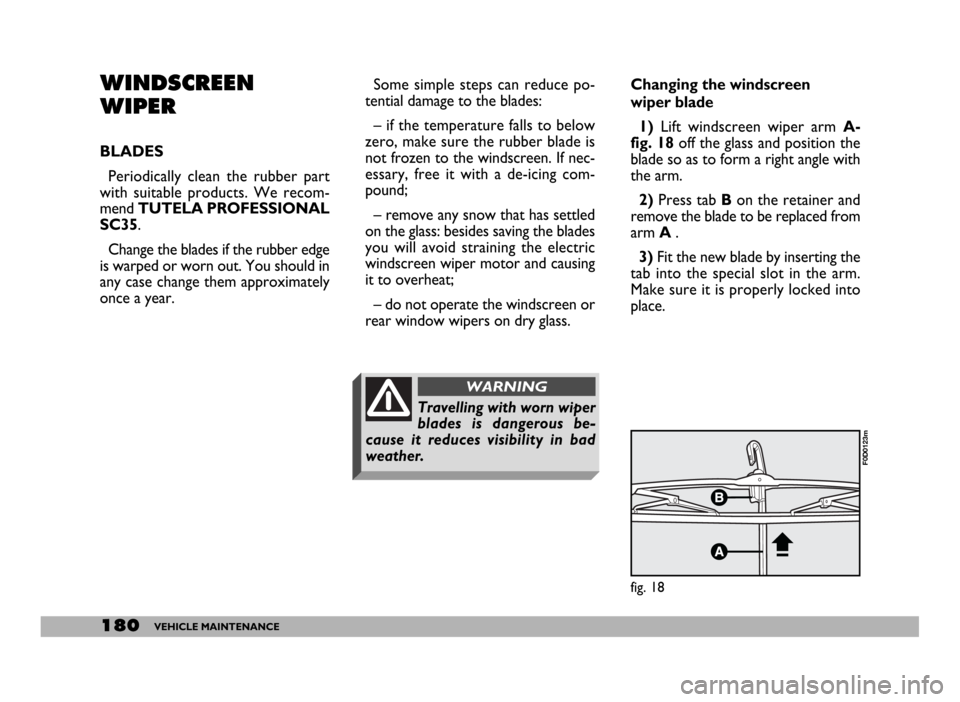Page 142 of 258

141IN AN EMERGENCY
GENERAL INSTRUCTIONS
When a light is not working, check
that it has not fused before changing
the bulb.
For the location of the fuses, refer to
“If a fuse blows” in this section.
Before replacing a bulb that does not
work, check that the contacts are not
oxidised.
Burnt-out bulbs must be replaced
with ones of the same type. Light from
bulbs with insufficient power is dim
while those which are too powerful
use too much electricity. Always check
the height of the headlight beam after
changing a bulb. Only touch the metal
part when handling halo-
gen bulbs. If the transpar-
ent bulb is touched it reduces the
intensity of the light emitted and
can also reduce the life of the
bulb. If you touch the bulb acci-
dentally, rub it with a cloth
moistened with alcohol and leave
it to dry.IF A BULB
BURNS OUT
Modifications or repairs to
the electrical system car-
ried out incorrectly and without
bearing the features of the system
in mind can cause malfunctions
with the risk of fire.
WARNING
You should have the bulbs
replaced at a Fiat Dealer-
ship, if possible. Correct operation
and proper beam height are essen-
tial for safe driving and compliance
with law requirements.
WARNING
Halogen bulbs contain
pressurised gas which, if
broken, may cause small fragments
of glass to be projected outwards.
WARNING
IMPORTANTOn the inside sur-
face of the headlight there could ap-
pear a slight coat of fogging; this does
not show a defect, since it is a natur-
al occurrence due to low temperature
and to the degree of humidity in the
air; it will disappear as soon as the
lights are turned on. The presence of
drops inside the headlight shows wa-
ter seepage, contact Fiat Dealership.
Page 172 of 258

171VEHICLE MAINTENANCE
WINDSCREEN WASHER
FLUID
To add fluid, remove cap A-fig. 10
from the reservoir and slowly pour in
a mixture of water and TUTELA
PROFESSIONAL SC35fluid in the
following concentrations:
– 30% ofTUTELA PROFES-
SIONAL SC35and 70% of water in
summer.
– 50% ofTUTELA PROFES-
SIONAL SC35and 50% of water in
winter.
If the temperature falls below –20°C,
useTUTELA PROFESSIONAL
SC35undiluted.
POWER STEERING
FLUID
Check the oil level when the engine
is cold. It should be slightly under the
reference line on the reservoir.
When the oil is hot, the level can ex-
ceed the reference line.
When topping up, remove the reser-
voir cap A-fig. 11 and make sure that
the oil has the same specifications as
the oil in the system.Oil consumption is ex-
tremely low. If the oil
level needs topping up
again after a short period of
time, have the system checked
for leakage at a Fiat Dealership.
fig. 10
F0D0068m
fig. 11
F0D0066m
Do not let the power steer-
ing fluid come into contact
with hot engine parts. It catches fire
very easily.
WARNINGSome windscreen washer
additives on the market are
flammable. The engine compart-
ment contains hot parts which
could ignite the fluid in the event of
contact.
WARNING
Do not travel with the wind-
screen washer reservoir
empty. The windscreen washer is
fundamental for improving visibility.
WARNING
Page 180 of 258

179VEHICLE MAINTENANCE
Tyres age even if they are not used
very much. Cracking of the tread rub-
ber and the side walls are a sign of this
ageing. In any case, if the tyres have
been fitted for more than six years
they should be examined by an expert
who can judge whether they are still
fit for use. Remember to check the
spare tyre particularly carefully too.
If a replacement is necessary, always
use new tyres and avoid using ones
the origin of which you are not cer-
tain about.
The Ducato uses tubeless tyres. Un-
der no circumstances use an inner
tube with these tyres.
If you replace a tyre it is a good idea
to change the inflation valve, too.To ensure the front and rear tyres all
wear evenly, you are advised to change
the tyres over every 10 - 15 thousand
kilometres keeping them on the same
side of the vehicle so as not to reverse
the direction of rotation.RUBBER TUBING
Follow the Service Schedule carefully
in the case of braking and fuel supply
system rubber tubing.
Ozone, high temperatures and long
absence of fluid in the system can in
fact cause the hardening and cracking
of the pipes with possible loss of fluid.
A careful check is therefore essential.
Do not change the tyres
over in criss-cross fashion
by moving a tyre from the left-hand
side of the vehicle to the right and
vice versa.
WARNING
Never submit alloy rims to
repainting treatments re-
quiring to use temperatures ex-
ceeding 150°C since the mechani-
cal properties of the wheels could
be impaired.
WARNING
Page 181 of 258

180VEHICLE MAINTENANCE
WINDSCREEN
WIPER
BLADES
Periodically clean the rubber part
with suitable products. We recom-
mend TUTELA PROFESSIONAL
SC35.
Change the blades if the rubber edge
is warped or worn out. You should in
any case change them approximately
once a year.Changing the windscreen
wiper blade
1)Lift windscreen wiper arm A-
fig. 18off the glass and position the
blade so as to form a right angle with
the arm.
2) Press tab Bon the retainer and
remove the blade to be replaced from
arm A .
3)Fit the new blade by inserting the
tab into the special slot in the arm.
Make sure it is properly locked into
place.
fig. 18
F0D0123m
Some simple steps can reduce po-
tential damage to the blades:
– if the temperature falls to below
zero, make sure the rubber blade is
not frozen to the windscreen. If nec-
essary, free it with a de-icing com-
pound;
– remove any snow that has settled
on the glass: besides saving the blades
you will avoid straining the electric
windscreen wiper motor and causing
it to overheat;
– do not operate the windscreen or
rear window wipers on dry glass.
Travelling with worn wiper
blades is dangerous be-
cause it reduces visibility in bad
weather.
WARNING
Page 240 of 258
239TECHNICAL SPECIFICATIONS
CAPACITIES
Fuel tank:
including a reserve of:
Engine cooling system:
Engine sump:
Transaxle:
Hydraulic power steering:
Front and rear hydraulic brake circuit:
11-15 versions
MAXI versions
Hydraulic brake circuit
with ABS:
11-15 versions
MAXI versions
Windscreen and rear window
liquid reservoir:
(▲) For particularly cold temperatures use SELENIA PERFORMER MULTIPOWER SAE 5W-30.
Prescribed fuel
Recommended products
Premium unleaded petrol with
a RON not lower than 95
Mixture of distilled water and
PARAFLU 11(blue) at 50% or
PARAFLU UP(red) at 50%
SELENIA 20K (▲)
TUTELA CAR MATRYX
TUTELA GI/A
TUTELA TOP 4
TUTELA TOP 4
Mixture of water andTUTELA
PROFESSIONAL SC 35 2000 BZ
Litres
80
8 ÷ 10
9
5
2.4
1.3
0.59
0.62
0.62
0.66
4.2 kg
–
–
–
4.5
2.16
–
–
–
–
–
–
Page 242 of 258
241TECHNICAL SPECIFICATIONS
FLUIDS AND LUBRICANTS
PRODUCTS WHICH MAY BE USED AND THEIR SPECIFICATIONS
Use
Lubricants
for petrol
engines (❐)
Lubricants
for diesel
engines
(❐) For particularly cold temperatures use SELENIA PERFORMER MULTIPOWER SAE 5W-30Applications
F0D0146m
Fluid and lubricant specifications
for correct vehicle operations
Synthetic-based oil, grade SAE 10W-40 that passes
ACEA A3, API SL specifications
Synthetic-based oil, grade SAE 5W-30 that passes
ACEA A1, ACEA A5, API SL and FIAT 9.55535
specifications.
Synthetic-based oil, grade SAE 5W-40 that passes ACEA B4,
API CF and FIAT 9.55535 specificationsRecommended
fluids and lubricants
SELENIA 20K
SELENIA
PERFORMER
MULTIPOWER
SELENIA WR
Page 243 of 258

242TECHNICAL SPECIFICATIONS
Use
Lubricants and grease
for transmission
Products for brakes
Radiatorantifreeze
Diesel fuel
additive
Windscreen/
rear window/
headlight washer fluid
(*) IMPORTANTThese two fluids cannot be mixed with each other. Contact Fiat Dealership for topping up.
Recommended
fluids and lubricants
TUTELA CAR
MATRYX
TUTELA GI/A
TUTELA HP 20
TUTELA
W 90/M-DA
TUTELA TOP 4
PARAFLU 11 (*)
or
PARAFLU UP (*)
DIESEL MIX
TUTELA
PROFESSIONAL
SC 35 Fluid and lubricant specifications
for correct vehicle operation
Fully synthetic lubricant SAE 75W-85 meeting API GL-4,
FIAT 9.55550
Lubricant for transmissions with ATF DEXRON II D LEV
properties
ATF DEXRON III oil type
Lubricant, grade SAE 80W-90 that passes API GL5, MIL-L-
2105 D, IVECO 18-1804, FIAT 9.55550 and FIAT 9.55523
specifications
Synthetic fluid, FMVSS n° 116 DOT 4, ISO 4925,
SAE J-1704, CUNA NC 956 - 01
Protective with antifreeze action based on
inhibited monoethylen glycol, CUNA NC 956-16
Protective with antifreeze action (red colour) based on inhib-
ited monoethylen glycol, with O.A.T. formulation, that passes
CUNA NC 956-16, ASTM D 3306 specifications.
Diesel fuel additive providing diesel engine protection
Mixture of alcohol and surfactants CUNA NC 956 -IIApplications
Mechanical
transaxles developping
high temperatures
Power steering system
Automatic gearbox
EP oil for standard and
self-locking differentials
Hydraulic brake and
clutch controls
Cooling circuits.
Proportion: 50% down
to -35° C Not to be
mixed with products
having different
formulas.
To be mixed with
diesel fuel
(25 cc every 10 litres)
To be used pure
or diluted
Page 244 of 258

243TECHNICAL SPECIFICATIONS
FUEL CONSUMPTION - CO2EMISSIONS
RUNNING AND USE CONDITIONS AFFECTING FUEL CONSUMPTION
(examples and differences with respect to goods transportation vehicle data)
IMPORTANT
Although fuel consumption mea-
surements procedure aim at defining
realistic values, fuel consumption is in-
fluenced by factors such as:
Driving style and vehicle usehigh
speed, frequent acceleration, frequent
gear shifting, door-to-door deliveries,
etc.
Just for passenger transportation
versions with 2.3 and 2.8 JTD engines,
reduced consumption can be obtained
by starting (on level road) in 2nd gear
instead of 1st gear.
Traffic and road conditions
queues, bending roads, steep roads,
bad road surface, etc.Weather conditions and tem-
peratures
low temperatures, thinner air, wind,
rain etc…;
Vehicle conditions
Poor maintenance (tyre pressure, fil-
ters, spark plugs, etc.), damaged body-
work
Load conditions
Heavy weights, not optimal load dis-
tribution, large weights on roof rack,
etc.
Use of electric devices
Climate control, heater and electric
devices in general
Special conditions of use
Special vehicle conditions of use: roof
rack, trailer, open side windows, type
of tyres, etc.Special trim and adaptations
caravan, motor home, mega box, can-
vas cover, etc.
Some of these conditions are illus-
trated in these figures on the next
pages.
For more information, refer to the
advice in the chapter “Cheap running
that respects the environment.
The fuel consumption values shown
in the table in following pages were de-
fined according to the type-approval
specifications in European Directives.
Consumption values are defined by
means of the following procedures:
– an urban cycle: consisting of a
cold start and a simulated drive in city
streets;
– an extra-urban cycle: consisting
in frequent accelerations, in all gears,